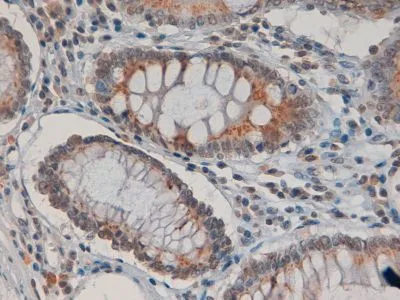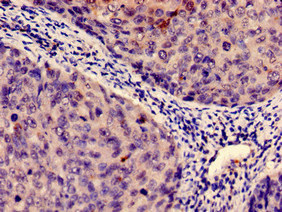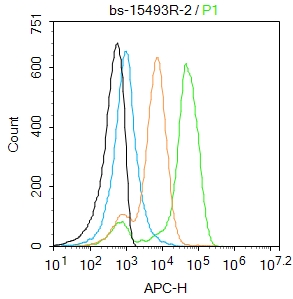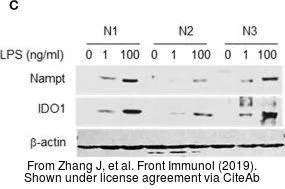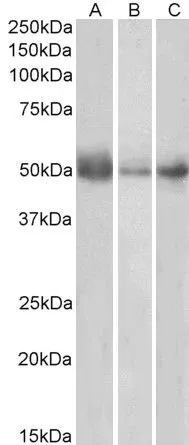
WB analysis of human lymph node (A), spleen (B) and placenta (C) lysates using GTX89419 IDO1 antibody, Internal. Dilution : 0.5microg/ml Loading : 35microg protein in RIPA buffer
IDO1 antibody, Internal
GTX89419
ApplicationsWestern Blot, ImmunoHistoChemistry, ImmunoHistoChemistry Paraffin
Product group Antibodies
TargetIDO1
Overview
- SupplierGeneTex
- Product NameIDO1 antibody, Internal
- Delivery Days Customer7
- Application Supplier NoteWB: 0.5-1.5microg/ml. *Optimal dilutions/concentrations should be determined by the researcher.Not tested in other applications.
- ApplicationsWestern Blot, ImmunoHistoChemistry, ImmunoHistoChemistry Paraffin
- CertificationResearch Use Only
- ClonalityPolyclonal
- Concentration0.50 mg/ml
- ConjugateUnconjugated
- Gene ID3620
- Target nameIDO1
- Target descriptionindoleamine 2,3-dioxygenase 1
- Target synonymsIDO, IDO-1, INDO, indoleamine 2,3-dioxygenase 1, indolamine 2,3 dioxygenase, indole 2,3-dioxygenase, indoleamine-pyrrole 2,3-dioxygenase
- HostGoat
- IsotypeIgG
- Protein IDP14902
- Protein NameIndoleamine 2,3-dioxygenase 1
- Scientific DescriptionThis gene encodes indoleamine 2,3-dioxygenase (IDO) - a heme enzyme that catalyzes the first and rate-limiting step in tryptophan catabolism to N-formyl-kynurenine. This enzyme acts on multiple tryptophan substrates including D-tryptophan, L-tryptophan, 5-hydroxy-tryptophan, tryptamine, and serotonin. This enzyme is thought to play a role in a variety of pathophysiological processes such as antimicrobial and antitumor defense, neuropathology, immunoregulation, and antioxidant activity. Through its expression in dendritic cells, monocytes, and macrophages this enzyme modulates T-cell behavior by its peri-cellular catabolization of the essential amino acid tryptophan.[provided by RefSeq, Feb 2011]
- Storage Instruction-20°C or -80°C,2°C to 8°C
- UNSPSC12352203

